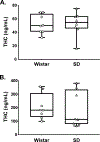Effects of Δ⁹-tetrahydrocannabinol (THC) vapor inhalation in Sprague-Dawley and Wistar rats
- PMID: 32297788
- PMCID: PMC8376092
- DOI: 10.1037/pha0000373
Effects of Δ⁹-tetrahydrocannabinol (THC) vapor inhalation in Sprague-Dawley and Wistar rats
Abstract
An inhalation system based on e-cigarette technology produces hypothermic and antinociceptive effects of Δ⁹-tetrahydrocannabinol (THC) in rats. Indirect comparison of some prior investigations suggested differential impact of inhaled THC between Wistar (WI) and Sprague-Dawley (SD) rats; thus, this study was conducted to directly compare the strains across inhaled and injected routes of administration. Groups (N = 8 per strain) of age-matched male SD and WI rats were prepared with radiotelemetry devices to measure temperature and then exposed to vapor from the propylene glycol (PG) vehicle or THC (25-200 mg/mL of PG) for 30 or 40 min. Additional studies evaluated effects of THC inhalation on plasma THC (50-200 mg/mL) and nociception (100-200 mg/mL) as well as the thermoregulatory effect of intraperitoneal injection of THC (5-30 mg/kg). Hypothermic effects of THC were more pronounced in SD rats, where plasma levels of THC were identical across strains, under either fixed inhalation conditions or injection of a mg/kg equivalent dose. Strain differences in hypothermia were largest after i.p. injection of THC, with SD rats exhibiting dose-dependent temperature reduction after 5 or 10 mg/kg, i.p. and the WI rats only exhibiting significant hypothermia after 20 mg/kg, i.p. The antinociceptive effects of inhaled THC (100, 200 mg/mL) did not differ significantly across the strains. These studies confirm an insensitivity of WI rats, compared with SD rats, to hypothermia induced by THC following inhalation conditions that produced identical plasma THC and antinociception. Thus, quantitative, albeit not qualitative, strain differences may be obtained when studying thermoregulatory effects of THC. (PsycInfo Database Record (c) 2021 APA, all rights reserved).
Conflict of interest statement
Figures









Similar articles
-
Explication of CB1 receptor contributions to the hypothermic effects of Δ9-tetrahydrocannabinol (THC) when delivered by vapor inhalation or parenteral injection in rats.Drug Alcohol Depend. 2020 Sep 1;214:108166. doi: 10.1016/j.drugalcdep.2020.108166. Epub 2020 Jul 16. Drug Alcohol Depend. 2020. PMID: 32717503 Free PMC article.
-
Appetitive, antinociceptive, and hypothermic effects of vaped and injected Δ-9-tetrahydrocannabinol (THC) in rats: exposure and dose-effect comparisons by strain and sex.Pharmacol Biochem Behav. 2021 Mar;202:173116. doi: 10.1016/j.pbb.2021.173116. Epub 2021 Jan 23. Pharmacol Biochem Behav. 2021. PMID: 33493547 Free PMC article.
-
Effects of Δ9-THC and cannabidiol vapor inhalation in male and female rats.Psychopharmacology (Berl). 2018 Sep;235(9):2541-2557. doi: 10.1007/s00213-018-4946-0. Epub 2018 Jun 16. Psychopharmacology (Berl). 2018. PMID: 29907926 Free PMC article.
-
Lasting effects of repeated ∆9 -tetrahydrocannabinol vapour inhalation during adolescence in male and female rats.Br J Pharmacol. 2020 Jan;177(1):188-203. doi: 10.1111/bph.14856. Epub 2019 Oct 31. Br J Pharmacol. 2020. PMID: 31478558 Free PMC article.
-
Tolerance to hypothermic and antinoceptive effects of ∆9-tetrahydrocannabinol (THC) vapor inhalation in rats.Pharmacol Biochem Behav. 2018 Sep;172:33-38. doi: 10.1016/j.pbb.2018.07.007. Epub 2018 Jul 19. Pharmacol Biochem Behav. 2018. PMID: 30031028 Free PMC article.
Cited by
-
Hyperactivity Induced By Vapor Inhalation of Nicotine in Male and Female Rats.bioRxiv [Preprint]. 2024 Feb 14:2024.02.12.579996. doi: 10.1101/2024.02.12.579996. bioRxiv. 2024. PMID: 38405720 Free PMC article. Preprint.
-
Effects of repeated adolescent exposure to cannabis smoke on cognitive outcomes in adulthood.J Psychopharmacol. 2021 Jul;35(7):848-863. doi: 10.1177/0269881120965931. Epub 2020 Dec 9. J Psychopharmacol. 2021. PMID: 33295231 Free PMC article.
-
Explication of CB1 receptor contributions to the hypothermic effects of Δ9-tetrahydrocannabinol (THC) when delivered by vapor inhalation or parenteral injection in rats.Drug Alcohol Depend. 2020 Sep 1;214:108166. doi: 10.1016/j.drugalcdep.2020.108166. Epub 2020 Jul 16. Drug Alcohol Depend. 2020. PMID: 32717503 Free PMC article.
-
Cannabis Use and Mental Illness: Understanding Circuit Dysfunction Through Preclinical Models.Front Psychiatry. 2021 Feb 5;12:597725. doi: 10.3389/fpsyt.2021.597725. eCollection 2021. Front Psychiatry. 2021. PMID: 33613338 Free PMC article. Review.
-
Appetitive, antinociceptive, and hypothermic effects of vaped and injected Δ-9-tetrahydrocannabinol (THC) in rats: exposure and dose-effect comparisons by strain and sex.Pharmacol Biochem Behav. 2021 Mar;202:173116. doi: 10.1016/j.pbb.2021.173116. Epub 2021 Jan 23. Pharmacol Biochem Behav. 2021. PMID: 33493547 Free PMC article.
References
-
- Aarde SM, Huang PK, Creehan KM, Dickerson TJ, & Taffe MA (2013). The novel recreational drug 3,4-methylenedioxypyrovalerone (MDPV) is a potent psychomotor stimulant: self-administration and locomotor activity in rats. Neuropharmacology, 71, 130–140. doi:10.1016/j.neuropharm.2013.04.003 - DOI - PMC - PubMed
MeSH terms
Substances
Grants and funding
LinkOut - more resources
Full Text Sources
Other Literature Sources
Medical

